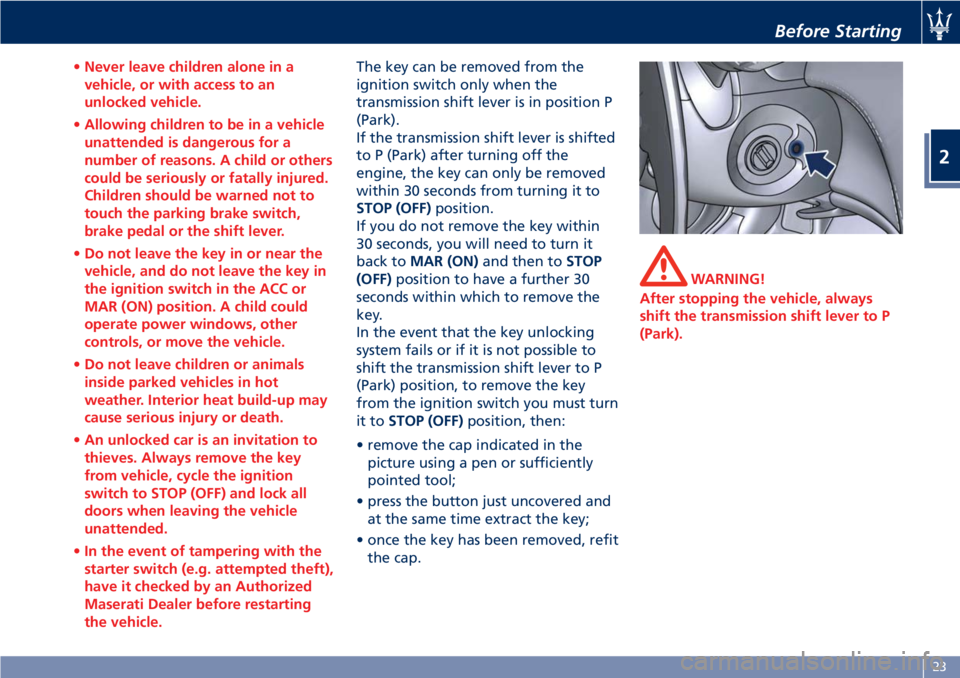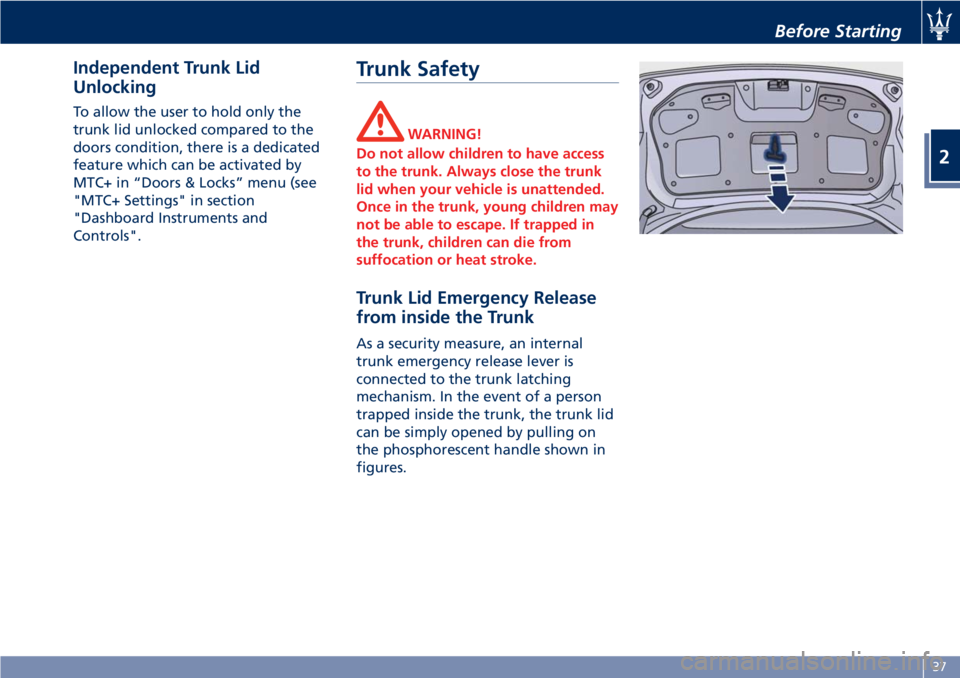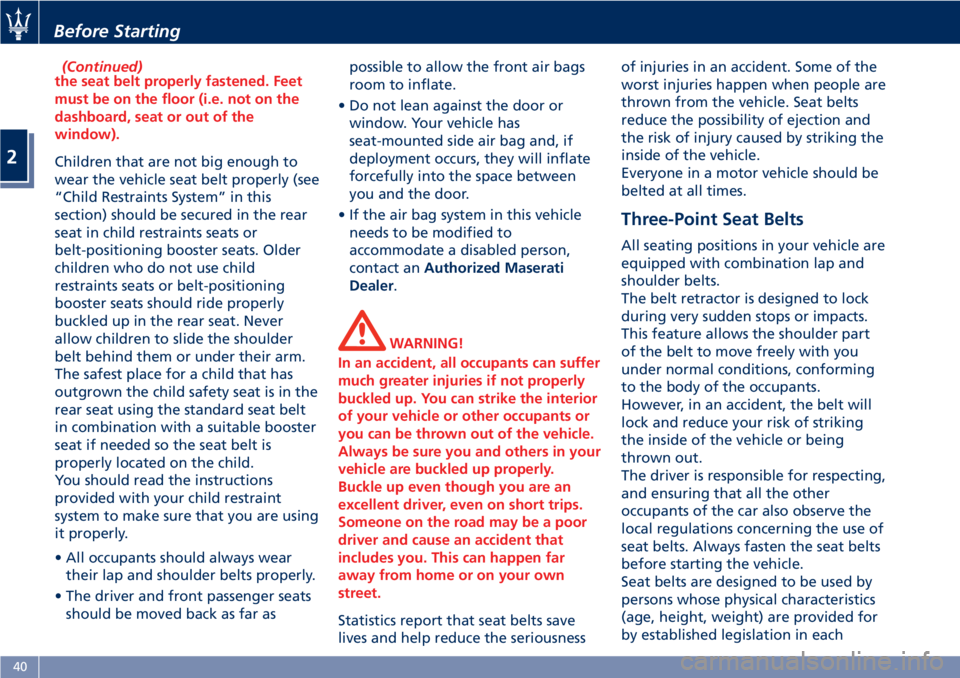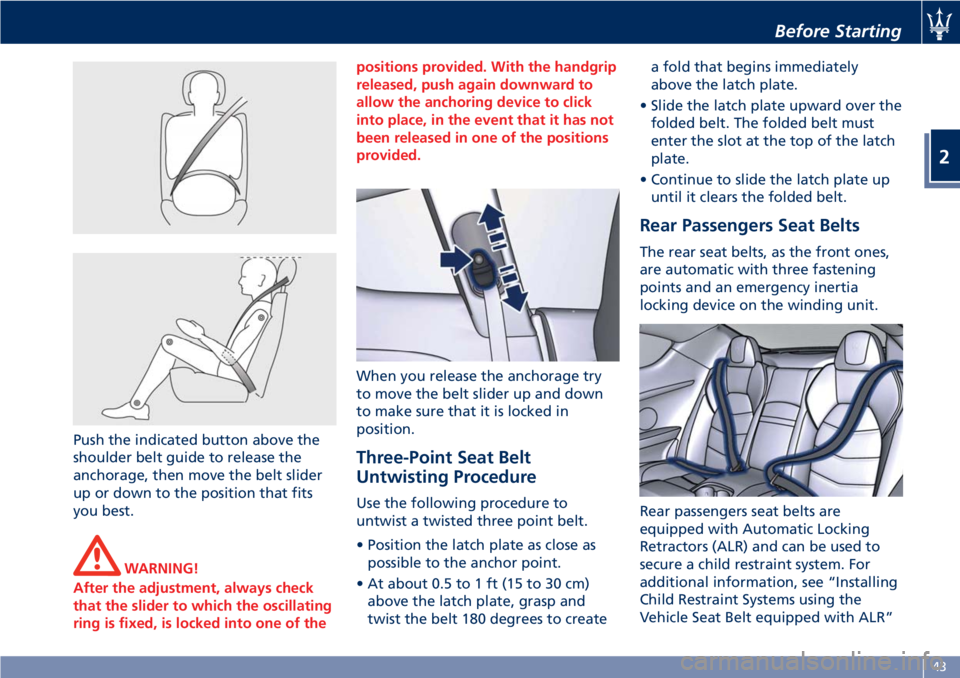2020 MASERATI GRANTURISMO child lock
[x] Cancel search: child lockPage 11 of 286

Abbreviations
Some descriptions and terms with
particular meanings are found in this
manual in abbreviated form.
A/CAir-Conditioning System.
ABSAnti-Lock Braking System.
ALCAdaptive Light Control.
ALRAutomatic Locking Retractor.
ASRAnti-Slip Regulation.
BOSBrake Override System.
CANController Area Network.
CCCruise Control.
CRSChild Restraint System.
DRLDaytime Running Lights.
EBDElectronic Brake-force
Distribution.
ECUElectronic Control Unit.
EDREvent Data Recorder.
EPBElectric Parking Brake.
ESCElectronic Stability Control.
ETDEmergency Tensioning
Device.
FTPFlash To Pass.
HBAHydraulic Brake Assistance.
ICEIncrease Control and
Efficiency.LATCHLower Anchors and Tether
for CHildren.
MILMalfunction Indicator Light.
MTC+Maserati Touch Control Plus.
OBDOn Board Diagnostics.
ORCOccupant Restraint
Controller.
RHDRight-Hand Drive.
SBRSeat Belt Reminder.
TFTThin Film Transistor.
TPMSTire Pressure Monitoring
System.
VINVehicle Identification
Number.
Updating
Constant improvements are being
performed to maintain this vehicle's
high level of quality. Therefore, there
may be differences between this
manual and your vehicle.
Maserati reserves the right to carry
out design and functional changes
and to provide updates or
improvements.
This Owner's Manual illustrates and
describes all versions of the current
vehicle model. Therefore, some of the
equipment and accessories in this
publication may not appear on your
vehicle; please only consider the
information related to your vehicle.
All specifications and illustrations
contained in this manual are as of the
Manual publishing date.
NOTE:
The updated version of the on-board
documentation can be consulted by
accessing the section “SERVICES” on
the websitewww.maserati.comor by
using the specific apps developed for
the more common Tablet and
Smartphone.
Introduction
1
7
Page 27 of 286

•Never leave children alone in a
vehicle, or with access to an
unlocked vehicle.
•Allowing children to be in a vehicle
unattended is dangerous for a
number of reasons. A child or others
could be seriously or fatally injured.
Children should be warned not to
touch the parking brake switch,
brake pedal or the shift lever.
•Do not leave the key in or near the
vehicle, and do not leave the key in
the ignition switch in the ACC or
MAR (ON) position. A child could
operate power windows, other
controls, or move the vehicle.
•Do not leave children or animals
inside parked vehicles in hot
weather. Interior heat build-up may
cause serious injury or death.
•An unlocked car is an invitation to
thieves. Always remove the key
from vehicle, cycle the ignition
switch to STOP (OFF) and lock all
doors when leaving the vehicle
unattended.
•In the event of tampering with the
starter switch (e.g. attempted theft),
have it checked by an Authorized
Maserati Dealer before restarting
the vehicle.The key can be removed from the
ignition switch only when the
transmission shift lever is in position P
(Park).
If the transmission shift lever is shifted
to P (Park) after turning off the
engine, the key can only be removed
within 30 seconds from turning it to
STOP (OFF)position.
If you do not remove the key within
30 seconds, you will need to turn it
back toMAR (ON)and then toSTOP
(OFF)position to have a further 30
seconds within which to remove the
key.
In the event that the key unlocking
system fails or if it is not possible to
shift the transmission shift lever to P
(Park) position, to remove the key
from the ignition switch you must turn
it toSTOP (OFF)position, then:
• remove the cap indicated in the
picture using a pen or sufficiently
pointed tool;
• press the button just uncovered and
at the same time extract the key;
• once the key has been removed, refit
the cap.
WARNING!
After stopping the vehicle, always
shift the transmission shift lever to P
(Park).
Before Starting
2
23
Page 34 of 286

The homologation number (EEC
regulations) of the radio control device
is indicated in the picture.
The current device feature is subject to
following conditions:
• This device may not cause harmful
interference.
• This device must accept any
interference received, including
interference that may cause
undesired operation.
If your transmitter device fails to
operate from a normal distance, check
for these two conditions:
• A weak battery in the transmitter
device. The expected life of the
battery in normal use is a minimum
of three years.
• Closeness to a radio transmitter such
as a radio station tower, airporttransmitter, and some mobile or CB
radios.Doors
WARNING!
•For personal security and safety in
the event of an accident, or robbery
lock the vehicle doors before you
drive as well as when parking and
leaving the vehicle unattended.
•When leaving the vehicle, always
remove the key and lock your
vehicle.
•Do not allow children to be in a
vehicle unattended or with access to
an unlocked vehicle. A child or
others could be seriously or fatally
injured. Children should be warned
not to touch the parking brake
trigger, brake pedal or the shift
lever.
•Do not leave the key in or near the
vehicle, and do not leave ignition
switch in the ACC or MAR (ON)
position. A child could operate
power windows, other controls, or
start the engine and the vehicle.
•Before opening a door, make sure
the maneuver can be performed
safely.
Before Starting
2
30
Page 38 of 286

NOTE:
•The power window switches will
remain active for up to 10 minutes
after the key in the ignition switch is
turned to theSTOP (OFF)position.
Opening either door will cancel this
feature.
•Frequent activations of the power
windows could result in a temporary
lock out of the motors. In this case,
wait a moment before a new
activation.
•If the power window is closed when
the door is open, the window stops
before the upper limit so as not to
interfere with the seal when the
door is closed.
WARNING!
•When the door is opened, the
window is automatically lowered
slightly; when the door is closed
again, the window is automatically
raised. Always ensure that
passengers (especially children) are
clear of the windows when
opening/closing the doors.
•Improper use of the power windows
can be dangerous. Ensure that
passengers are clear of the windows
before closing them. When leaving
the vehicle, always remove the key
from the ignition switch to prevent
the power windows from being
accidentally activated: this could
endanger any passengers remaining
in the vehicle.
•Never leave unattended children in a
vehicle.
Auto-Down Feature
The driver door power window switch
and some model passenger door
power window switches have an
auto-down feature.
Press the window switch to the second
detent, release, and the window will
go completely down automatically.To open the window part way, press
the window switch to the first detent
and release it when you want the
window to stop.
To stop the window from going all the
way down during the auto-down
operation, pull up on the switch
briefly.
Auto-Up Feature
Lift the window switch to the second
detent, release, and the window will
go all the way up automatically.
To stop the window from going all the
way up during the auto-up operation,
push down on the switch briefly.
To close the window part way, lift the
window switch to the first detent and
release it when you want the window
to stop.
NOTE:
•Any impact due to rough road
conditions may trigger the auto
reverse function unexpectedly during
auto-closure. If this happens, pull the
switch lightly to the first detent and
hold to close the window manually.
Before Starting
2
34
Page 41 of 286

Independent Trunk Lid
Unlocking
To allow the user to hold only the
trunk lid unlocked compared to the
doors condition, there is a dedicated
feature which can be activated by
MTC+ in “Doors & Locks” menu (see
"MTC+ Settings" in section
"Dashboard Instruments and
Controls".
Trunk Safety
WARNING!
Do not allow children to have access
to the trunk. Always close the trunk
lid when your vehicle is unattended.
Once in the trunk, young children may
not be able to escape. If trapped in
the trunk, children can die from
suffocation or heat stroke.
Trunk Lid Emergency Release
from inside the Trunk
As a security measure, an internal
trunk emergency release lever is
connected to the trunk latching
mechanism. In the event of a person
trapped inside the trunk, the trunk lid
can be simply opened by pulling on
the phosphorescent handle shown in
figures.
Before Starting
2
37
Page 43 of 286

Occupants Restraint
Systems
The listed occupants restraint systems
are some of the most important safety
features in your vehicle:
• Three-point seat belts (also called lap
and shoulder belts) for the driver
and all passengers.
• Front air bags for driver and
passenger.
• Seat-mounted side air bags for the
driver and front passenger.
• An energy-absorbing steering
column and steering wheel.
• Seat belts incorporate a pretensioner
(Emergency Tensioning Device - ETD)
that may enhance occupant
protection by managing the energy
created during an impact.
• All seat belt retractors are equipped
with load limiting devices which
control the seat belt reeling out so
as to adjust the force exerted on the
shoulders while the seat belt is in
restraining mode.
• All seat belts system (except the
driver’s) include Automatic Locking
Retractors (ALR), which lock the seat
belt webbing into position by
extending the belt all the way outand then adjusting the belt to the
desired length to restrain a child seat
or secure a large item in a seat.
Please pay close attention to the
information in this section. It tells you
how to use your restraint system
properly, to keep you and your
passengers as safe as possible.
If you are carrying children too small
for adult-sized seat belts, the seat
belts or the Lower Anchors and Tether
for CHildren (LATCH) feature also can
be used to hold infant and child
restraint systems. For more
information on LATCH, refer to
“Lower Anchors and Tether for
CHildren (LATCH)” in this section.
WARNING!
To help provide maximum protection,
you are advised to keep the seatback
in the most upright position possible
and the seat belt close to your chest
and pelvis. If the seat belt is loose, in
the event of an accident you could
move too far forward and could be
injured. Travelling with the seatback
too far reclined could also be
dangerous: even if the seat belts are
fastened, they may not work
correctly. In fact, the belt itself may
not be close enough to your bodyand, if it is in front of you, it could
cause neck wounds or other injuries in
an accident. Additionally, in an
accident, the lower section of the belt
could press against the upper part of
your stomach rather than the pelvic
area, causing serious internal injuries.
Here are some simple steps you can
take to minimize the risk of harm
from a deploying air bag:
• Children 12 years old and under
should always ride buckled up in a
rear seat.
WARNING!
Infants in rear facing child restraints
should never ride in the front seat of
a vehicle with a passenger front air
bag. An air bag deployment can cause
severe or fatal injury to infants in that
position.
Do not use child seats or child booster
cushions/backrests in the front
passenger seat. Occupants in the front
passenger seat must never sit on the
edge of the seat, leaning toward the
dashboard or otherwise sit out of
position. The occupants’ back must be
as upright as comfort allows, and
must rest against the seatback with
(Continued)
Before Starting
2
39
Page 44 of 286

(Continued)
the seat belt properly fastened. Feet
must be on the floor (i.e. not on the
dashboard, seat or out of the
window).
Children that are not big enough to
wear the vehicle seat belt properly (see
“Child Restraints System” in this
section) should be secured in the rear
seat in child restraints seats or
belt-positioning booster seats. Older
children who do not use child
restraints seats or belt-positioning
booster seats should ride properly
buckled up in the rear seat. Never
allow children to slide the shoulder
belt behind them or under their arm.
The safest place for a child that has
outgrown the child safety seat is in the
rear seat using the standard seat belt
in combination with a suitable booster
seat if needed so the seat belt is
properly located on the child.
You should read the instructions
provided with your child restraint
system to make sure that you are using
it properly.
• All occupants should always wear
their lap and shoulder belts properly.
• The driver and front passenger seats
should be moved back as far aspossible to allow the front air bags
room to inflate.
• Do not lean against the door or
window. Your vehicle has
seat-mounted side air bag and, if
deployment occurs, they will inflate
forcefully into the space between
you and the door.
• If the air bag system in this vehicle
needs to be modified to
accommodate a disabled person,
contact anAuthorized Maserati
Dealer.
WARNING!
In an accident, all occupants can suffer
much greater injuries if not properly
buckled up. You can strike the interior
of your vehicle or other occupants or
you can be thrown out of the vehicle.
Always be sure you and others in your
vehicle are buckled up properly.
Buckle up even though you are an
excellent driver, even on short trips.
Someone on the road may be a poor
driver and cause an accident that
includes you. This can happen far
away from home or on your own
street.
Statistics report that seat belts save
lives and help reduce the seriousnessof injuries in an accident. Some of the
worst injuries happen when people are
thrown from the vehicle. Seat belts
reduce the possibility of ejection and
the risk of injury caused by striking the
inside of the vehicle.
Everyone in a motor vehicle should be
belted at all times.
Three-Point Seat Belts
All seating positions in your vehicle are
equipped with combination lap and
shoulder belts.
The belt retractor is designed to lock
during very sudden stops or impacts.
This feature allows the shoulder part
of the belt to move freely with you
under normal conditions, conforming
to the body of the occupants.
However, in an accident, the belt will
lock and reduce your risk of striking
the inside of the vehicle or being
thrown out.
The driver is responsible for respecting,
and ensuring that all the other
occupants of the car also observe the
local regulations concerning the use of
seat belts. Always fasten the seat belts
before starting the vehicle.
Seat belts are designed to be used by
persons whose physical characteristics
(age, height, weight) are provided for
by established legislation in each
Before Starting
2
40
Page 47 of 286

Push the indicated button above the
shoulder belt guide to release the
anchorage, then move the belt slider
up or down to the position that fits
you best.
WARNING!
After the adjustment, always check
that the slider to which the oscillating
ring is fixed, is locked into one of thepositions provided. With the handgrip
released, push again downward to
allow the anchoring device to click
into place, in the event that it has not
been released in one of the positions
provided.
When you release the anchorage try
to move the belt slider up and down
to make sure that it is locked in
position.
Three-Point Seat Belt
Untwisting Procedure
Use the following procedure to
untwist a twisted three point belt.
• Position the latch plate as close as
possible to the anchor point.
• At about 0.5 to 1 ft (15 to 30 cm)
above the latch plate, grasp and
twist the belt 180 degrees to createa fold that begins immediately
above the latch plate.
• Slide the latch plate upward over the
folded belt. The folded belt must
enter the slot at the top of the latch
plate.
• Continue to slide the latch plate up
until it clears the folded belt.
Rear Passengers Seat Belts
The rear seat belts, as the front ones,
are automatic with three fastening
points and an emergency inertia
locking device on the winding unit.
Rear passengers seat belts are
equipped with Automatic Locking
Retractors (ALR) and can be used to
secure a child restraint system. For
additional information, see “Installing
Child Restraint Systems using the
Vehicle Seat Belt equipped with ALR”
Before Starting
2
43